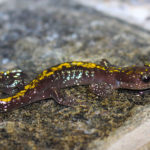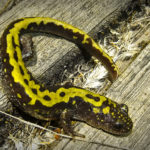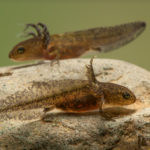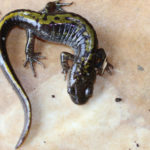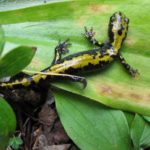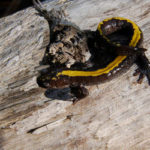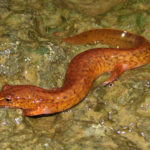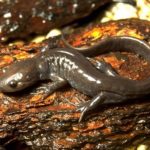Home > Salamanders > Long Toed Salamander
Long Toed Salamander
Long toed salamander is a species of mole salamander found in North America. There are five recognized subspecies of this species.
| Kingdom | Animalia |
| Phylum | Chordata |
| Class | Amphibia |
| Order | Caudata |
| Family | Ambystomatidae |
| Genus | Ambystoma |
| Scientific Name | Ambystoma macrodactylum |
| Size | Around 8 cm (Snout to vent length); Around 14 cm (total length) |
| Weight | Largest specimen weigh around 7.5 g |
| Color | Patches of Black, brown, and yellow; grayish underside |
| Distribution | United States, Canada |
| Habitat | Temperate rainforests, coniferous forests, red fir forest, sagebrush plains, semiarid sagebrush, cheatgrass plains, montane riparian, alpine meadows along the rocky shores of mountain lakes at an elevation of up to 2800 m |
| Diet | Insects, beetles, worms, tadpoles, small fish |
| Hibernation Fact | Hibernate during the cold winter months in groups in the northern part of its range |
| Predators | Garter snakes, small mammals, birds, fish |
| Breeding Season | Individuals living in lower elevation breed in the fall, winter, and early spring whereas individuals living in higher elevation breed in spring and early summer |
| Mode of Reproduction | Oviparous (egg laying) |
| Clutch Size | Varies with elevations; up to 400 eggs |
| Incubation Period | 2 to 6 weeks |
| Reproductive Age | 2 to 3 years of age |
| Average Lifespan | 6 to 10 years |
| IUCN Conservation Status | Least Concern |
Long Toed Salamander Pictures Gallery
- Ambystoma Macrodactylum
- Long Toed Salamander Egg Mass
- Long Toed Salamander Eggs
- Long Toed Salamander Habitat
- Long Toed Salamander Images
- Long Toed Salamander Larvae
- Long Toed Salamander
- Long Toed Salamanders
- LongToed Salamander Pictures
- Long-toed Salamander
Published on March 10th 2017 by staff under Salamanders. Article was last reviewed on 30th September 2019.
